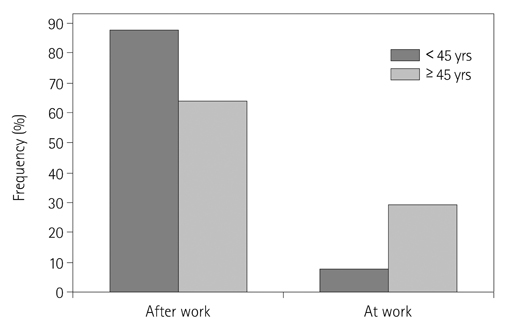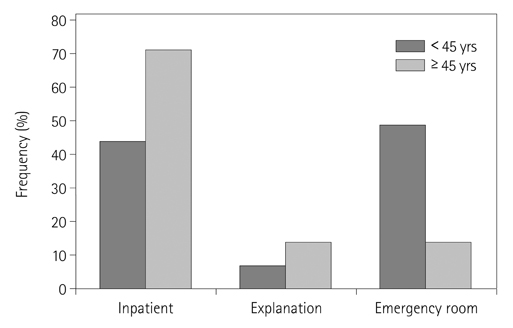J Korean Soc Radiol.
2013 Jan;68(1):71-76.
Survey of the Use Pattern and Satisfaction of Mobile Picture Archiving and Communication System Users with Tablet Personal Computer
- Affiliations
-
- 1Department of Radiology, Kangbuk Samsung Hospital, Sungkyunkwan University School of Medicine, Seoul, Korea. parkhiji@gmail.com
- 2Department of Radiology, School of Medicine, Kangwon National University, Chuncheon, Korea.
- 3Department of Laboratory Medicine, Kangbuk Samsung Hospital, Sungkyunkwan University School of Medicine, Seoul, Korea.
Abstract
- PURPOSE
The purpose of this study is to investigate the use pattern, satisfaction, dissatisfaction, and general opinion of the physicians from mobile Picture Archiving and Communication System (PACS) use with galaxy tab 10.1.
MATERIALS AND METHODS
A survey questionnaire was distributed to 146 physicians of one medical center, and a total of 105 physicians responded. The questionnaire aimed to investigate of the physicians' use pattern, convenience, discomforts, satisfaction, degree of help to diagnose and treat, general opinion, and other opinions. The responses elicited, as well as discrepancies among the departments, and ages were assessed. Chi-square and Fisher's exact were used to determine the value of data.
RESULTS
The frequency of usage of the mobile PACS by the medical (75%) and surgical (78%) clinicians was higher than the supporting clinicians (48%) (p = 0.017). The uses and time of utilizing showed statistically significant difference among ages (p = 0.011, p = 0.038). Most of the young group (< 45) used after work on dealing with patients of the emergency room and inpatients. However, old group (> or = 45) used at work more than young group, and most of them used on dealing with the inpatients. The mean satisfaction score regarding the degree of help and about the satisfaction were 3.1 and 3.4, respectively.
CONCLUSION
The frequency of the use of the mobile PACS by medical and surgical clinicians was higher than supporting clinicians. There were statistically significant differences in the times and uses between the young and old groups, but not among the clinical departments. The satisfaction of the use of mobile PACS was moderate degree.
Figure
Reference
-
1. Yamamoto LG, Williams DR. A demonstration of instant pocket wireless CT teleradiology to facilitate stat neurosurgical consultation and future telemedicine implications. Am J Emerg Med. 2000. 18:423–426.2. Johnston WK 3rd, Patel BN, Low RK, Das S. Wireless teleradiology for renal colic and renal trauma. J Endourol. 2005. 19:32–36.3. Yaghmai V, Kuppuswami S, Berlin JW, Salehi SA. Evaluation of personal digital assistants as an interpretation medium for computed tomography of patients with intracranial injury. Emerg Radiol. 2003. 10:87–89.4. McLeod TG, Ebbert JO, Lymp JF. Survey assessment of personal digital assistant use among trainees and attending physicians. J Am Med Inform Assoc. 2003. 10:605–607.5. ACP-ASIM survey finds nearly half of U.S. members use handheld computers. ACP-ASIM Online. 2001. 10. 25. Available at: http://www.acponline.org/pressroom/handheld_survey.htm.6. Boonn WW, Flanders AE. Informatics in radiology (infoRAD): survey of personal digital assistant use in radiology. Radiographics. 2005. 25:537–541.7. Mc Laughlin P, Neill SO, Fanning N, Mc Garrigle AM, Connor OJ, Wyse G, et al. Emergency CT brain: preliminary interpretation with a tablet device: image quality and diagnostic performance of the Apple iPad. Emerg Radiol. 2012. 19:127–133.
- Full Text Links
- Actions
-
Cited
- CITED
-
- Close
- Share
- Similar articles
-
- Analysis and Problems of Urolgic Counseling by PC Communication
- Application of the Extended Technology Acceptance Model to Picture Archiving and Communication Systems in Dental Hospitals
- Survey User Satisfaction in Aspect of User Interactions With an Order Communication System in Seoul National University Hospital
- Effect of the Computerized Emergency Consultation System on Communication Between Medical Staff for Emergency Care
- The Remote Health System utilizing Wireless Communication of Personal Health Information




